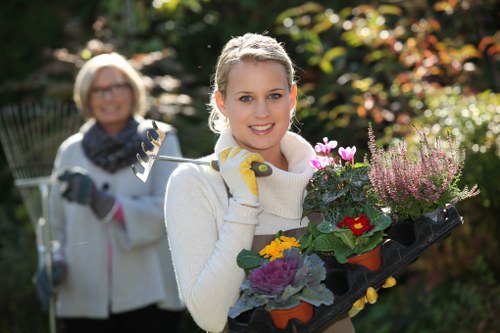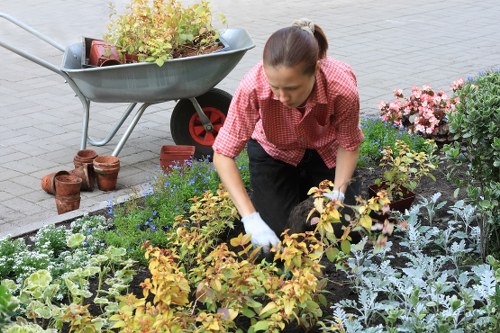Comprehensive Guide to Garden Fence Installation in Mowing London
Introduction to Garden Fencing

Gardening is not just a hobby; it's a way to enhance the beauty and functionality of your outdoor space. One crucial element that contributes to this is the garden fence. Whether you're looking to add privacy, define boundaries, or simply add aesthetic value, installing a garden fence is a worthwhile investment.
In Mowing, London, the unique climate and urban landscape present specific challenges and opportunities for garden fence installation. This guide will walk you through everything you need to know to make an informed decision.
From choosing the right materials to understanding local regulations, we've got you covered. Let's delve into the essentials of garden fence installation in Mowing London.
Benefits of Installing a Garden Fence

Garden fences offer numerous advantages that go beyond mere aesthetics. Here are some key benefits:
- Privacy: Create a secluded area for relaxation and enjoyment.
- Security: Deter unwanted animals and intruders.
- Boundary Definition: Clearly mark the limits of your property.
- Aesthetic Appeal: Enhance the overall look of your garden.
- Wind Protection: Shield your plants from harsh winds.
Understanding these benefits can help you prioritize your needs when selecting and installing a fence.
Moreover, a well-installed fence can add significant value to your property, making it a smart long-term investment.
Choosing the Right Fence Material

Selecting the appropriate material is crucial for the longevity and functionality of your fence. Here are some popular options available in Mowing London:
- Wood: Offers a classic and natural look, perfect for traditional gardens.
- Metal: Includes options like wrought iron and aluminum, known for durability and minimal maintenance.
- Vinyl: A low-maintenance alternative that mimics the appearance of wood.
- Composite: A combination of materials that provides strength and aesthetic flexibility.
Each material has its pros and cons, so consider factors like maintenance, cost, and desired appearance when making your choice.
Additionally, the climate in Mowing London can influence your material selection, as some materials perform better in certain weather conditions.
Understanding Local Regulations

Before installing a garden fence in Mowing London, it's essential to familiarize yourself with local building codes and regulations. These may include:
- Height restrictions
- Permit requirements
- Setback rules from property lines
- Material and design guidelines
Failing to adhere to these regulations can result in fines or the removal of your fence. Therefore, consulting with local authorities or a professional installer is highly recommended.
Additionally, understanding the Homeowners Association (HOA) rules, if applicable, can prevent future complications.
Step-by-Step Installation Process

Installing a garden fence involves several steps to ensure a sturdy and lasting structure. Here's a detailed walkthrough:
- Planning: Measure your garden area and decide on the fence layout.
- Selecting Materials: Choose the appropriate materials based on your needs.
- Preparing the Site: Clear the installation area and mark fence posts locations.
- Setting Fence Posts: Dig holes and set posts securely using concrete.
- Installing Panels: Attach fence panels to the posts, ensuring they are level and aligned.
- Finishing Touches: Add gates, trim, and any decorative elements.
Following these steps meticulously will help in achieving a professional and durable fence installation.
It's advisable to hire experienced professionals, especially if you're unfamiliar with fencing techniques.
Maintenance Tips for Longevity
To ensure your garden fence remains in excellent condition, regular maintenance is essential. Here are some tips:
- Regular Cleaning: Remove dirt, debris, and organic matter to prevent deterioration.
- Inspect for Damage: Check for loose boards, rust, or signs of wear and address them promptly.
- Protective Coatings: Apply paint or sealant to wood and metal fences to prevent weather damage.
- Vegetation Control: Keep plants and vines trimmed to avoid overgrowth and structural stress.
- Repairs: Replace damaged sections immediately to maintain fence integrity.
Proper maintenance can significantly extend the lifespan of your garden fence, ensuring it continues to serve its purpose effectively.
Moreover, regular upkeep enhances the overall appearance of your outdoor space.
Hiring Professional Installers
While DIY fence installation is possible, hiring professionals offers several advantages:
- Expertise: Professionals have the necessary skills and experience for a quality installation.
- Time Efficiency: Reduce the time and effort required for installation.
- Compliance: Ensure adherence to local regulations and standards.
- Warranty: Benefit from warranties and guarantees on workmanship.
- Cost-Effectiveness: Avoid costly mistakes and ensure long-term durability.
Choosing a reputable installer in Mowing London can provide peace of mind and a seamlessly executed fence installation.
Additionally, professionals can offer valuable advice on the best materials and designs suited to your specific needs.
Cost Considerations
The cost of garden fence installation in Mowing London varies based on several factors:
- Material: Different materials come with varying price points.
- Size: The length and height of the fence impact the overall cost.
- Design: More intricate designs may require additional labor and materials.
- Installation Complexity: Challenging terrain or existing structures can increase costs.
- Professional Fees: Hiring experts adds to the total expense but ensures quality.
It's advisable to obtain multiple quotes and compare them to find the best value for your investment.
Budgeting appropriately can help you achieve the desired outcome without financial strain.
Choosing the Perfect Fence Design
Fencing design plays a significant role in complementing your garden's aesthetic. Here are some popular styles:
- Traditional Picket Fences: Ideal for a classic, charming look.
- Modern Minimalist Fences: Feature clean lines and contemporary materials.
- Rustic Wooden Fences: Provide a natural and warm appearance.
- Metal Panels: Offer durability with a sleek, industrial feel.
- Ornamental Iron Fences: Add intricate designs and elegance.
Selecting a design that aligns with your garden's theme enhances the overall visual appeal.
Consider the surrounding architecture and natural elements to ensure a harmonious integration.
Environmental Considerations
Eco-friendly fencing options are becoming increasingly popular. Here are some sustainable choices:
- Recycled Materials: Utilize materials like recycled wood or metal.
- Sustainable Wood: Choose FSC-certified lumber to ensure responsible sourcing.
- Bamboo Fences: A rapidly renewable resource that offers a unique look.
- Living Fences: Incorporate plants and greenery for a natural barrier.
- Low-VOC Finishes: Use environmentally friendly paints and sealants.
Opting for sustainable materials minimizes environmental impact and promotes eco-conscious living.
Furthermore, green fences can contribute to better air quality and provide additional benefits like shade and habitat for wildlife.
Enhancing Security with Fencing
A secure fence is paramount for ensuring the safety of your property and loved ones. Here are ways to enhance security:
- Height: Taller fences are more effective in deterring intruders.
- Material: Strong materials like metal or reinforced wood provide better security.
- Locks and Gates: Install secure locks and sturdy gates to prevent unauthorized access.
- Visibility: Ensure the fence does not have blind spots that could be exploited.
- Lighting: Incorporate lighting to deter potential threats during nighttime.
By focusing on these elements, you can create a fortified perimeter that enhances your garden's safety.
Additionally, security features add peace of mind, especially in urban settings like Mowing London.
Integrating Fencing with Landscape Design
A well-integrated fence complements your landscape rather than detracting from it. Consider the following tips:
- Color Coordination: Match fence colors with existing structures and plants.
- Material Harmony: Use materials that blend seamlessly with the natural surroundings.
- Height and Proportion: Ensure the fence height is proportionate to your garden size.
- Decorative Elements: Add features like trellises or lattice work for added interest.
- Greenery: Incorporate climbing plants or vines to soften the fence's appearance.
Thoughtful integration ensures that your fence enhances the overall beauty and functionality of your garden.
Working with a landscape designer can provide professional insights into effective fence integration.
Navigating Permits and Approvals
Securing the necessary permits is a critical step in garden fence installation. Here's how to navigate the process:
- Research Local Requirements: Understand the specific permit requirements in Mowing London.
- Submit Applications: Complete and submit the necessary forms to local authorities.
- Provide Detailed Plans: Include fence dimensions, materials, and design specifications.
- Await Approval: Wait for authorities to review and approve your application.
- Schedule Inspections: Arrange for inspections if required by local regulations.
Following this process ensures legal compliance and prevents potential legal issues down the line.
Consulting with a professional installer can streamline the permit acquisition process.
Budgeting for Your Fence Project
Effective budgeting is essential for a successful fence installation. Consider the following factors:
- Material Costs: Different materials vary in price.
- Labor Expenses: Professional installation fees.
- Additional Features: Gates, decorative elements, and hardware.
- Permitting Fees: Costs associated with obtaining necessary permits.
- Contingency Fund: Allocate extra funds for unexpected expenses.
Creating a detailed budget helps in managing expenses and ensures the project stays financially on track.
It's also beneficial to obtain multiple quotes to compare costs and find the best value.
Common Challenges and Solutions
Garden fence installations can encounter various challenges. Here are some common issues and their solutions:
- Uneven Ground: Level the area or use adjustable posts.
- Poor Drainage: Implement proper drainage solutions to prevent water damage.
- Existing Obstacles: Carefully maneuver around trees, utility lines, and other structures.
- Material Durability: Choose high-quality, weather-resistant materials.
- Installation Errors: Hire experienced professionals to minimize mistakes.
Addressing these challenges proactively ensures a smooth installation process and a durable fence.
Regularly consulting with your installer can help in identifying and mitigating potential issues early on.
Final Thoughts on Garden Fence Installation
Installing a garden fence in Mowing London is a significant undertaking that requires careful planning and execution. By understanding the benefits, selecting the right materials, adhering to local regulations, and hiring professional installers, you can achieve a beautiful and functional fence that enhances your outdoor space.
Remember to consider long-term maintenance and integrate the fence seamlessly with your landscape design to maximize its value and appeal.
Don't hesitate to contact us today to discuss your garden fence installation needs and transform your garden into a secure and aesthetically pleasing haven.
Take the first step towards your perfect garden by booking your service now.